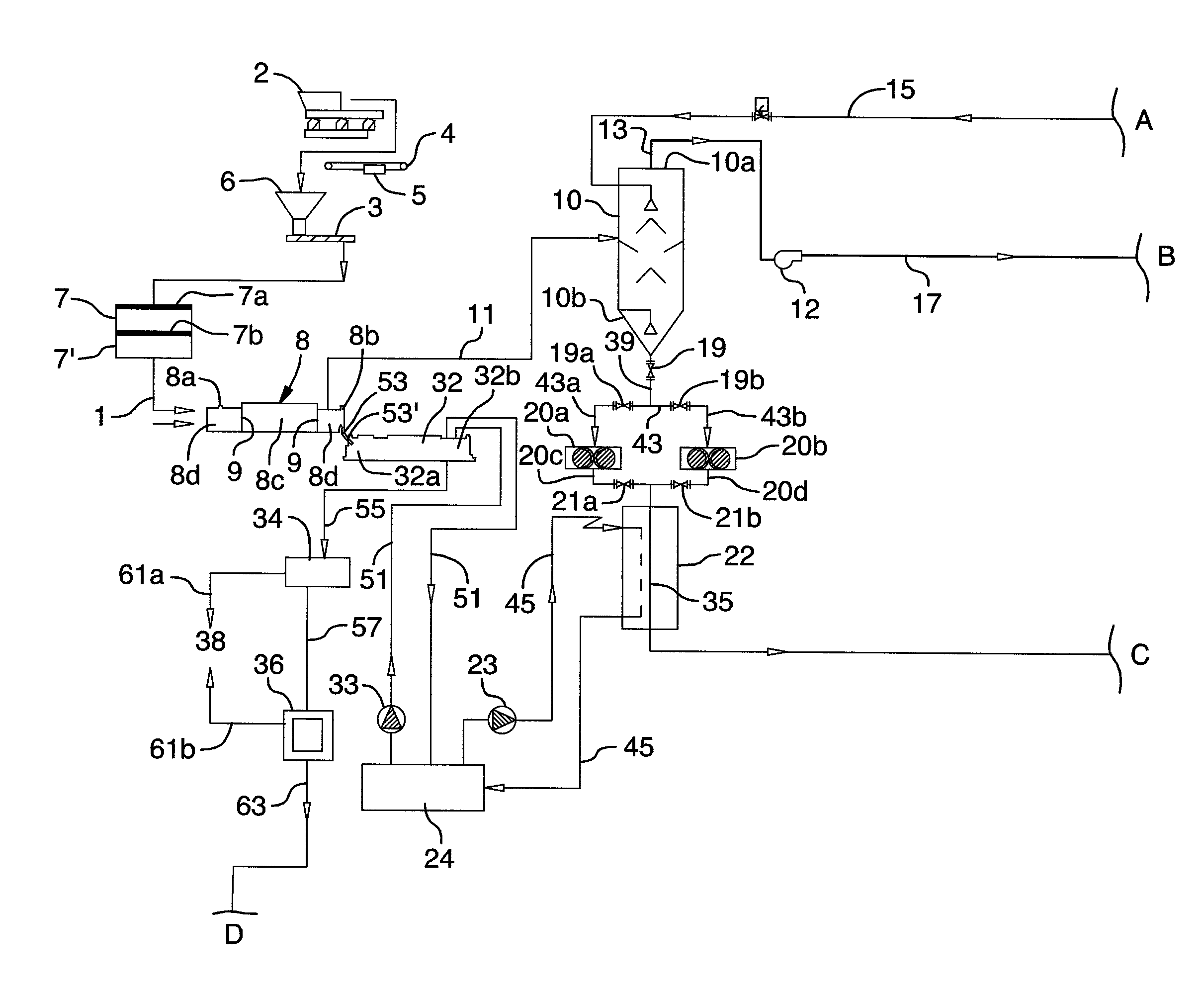Method of reclaiming carbonaceous materials from scrap tires and products derived therefrom
a carbonaceous material and scrap tire technology, applied in the field of waste recycling, can solve the problems of difficult and expensive scrap tire breakage, large environmental hazard of continuing accumulation of scrap tires, and the inability of recycled rubber products to meet the quality of scrap tires
- Summary
- Abstract
- Description
- Claims
- Application Information
AI Technical Summary
Benefits of technology
Problems solved by technology
Method used
Image
Examples
example 1
[0109]Cleaned rubber tire shreds of 2″ (on the diagonal) were pyrolyzed in an anaerobic environment at four different temperatures: 450° C., 500° C., 600° C. and 700° C. Table 1 shows the process mass balance at the various pyrolysis temperatures. It can been seen that pyrolysis carried out at the higher temperatures favour oil production and while the lower operating temperatures favour char production.
[0110]
TABLE 1TempTempComposition % Wt(° C.)(° F.)GasesOilCharTotal4508425.840.246.292.25009323.142.343.789.160011126.244.340.59170012925.745.538.689.8
[0111]Table 2 shows the gross calorific value and sulphur content of the oil and char generated at the four experimental pyrolysis temperatures. The results indicate that the oil sulphur content is greater at the higher pyrolysis temperatures and that contrarily, the char's sulphur content increases as the pyrolysis temperature is lowered.
[0112]
TABLE 2CorrectedCorrectedTempTempGCV MJ / KGCV MJ / KGSulphur Content %(° C.)(° F.)OilCharOilChar...
example 2
[0131]Used rubber tire shreds of 1½″ or less were pyrolyzed at 450° C. in an inert nitrogen atmosphere. Following a cooling period, the char was collected and the steel removed with the use of a magnet. The crude CBp was milled to pass a 325-mesh sieve. The milled CBp (bulk density of 25 lb / ft3) was mixed with 1% Norlig G (calcium lignosulphonate binder) then pelletized using an agglomerator. The product was subsequently dried at a temperature of 120° C. and the product screened at 2.0×150 microns (10×100 mesh). The bulk density of the pellets produced was approximately 35 lb / ft3.
example 2a
[0132]The pelletized CBp was subsequently tested in two natural rubber formulations (ASTM D3192). Rubber compound A was formulated with conventional N-762 and rubber compound B with the CBp. The results are presented in Tables 8, 9 and 10.
[0133]
TABLE 8Compound ACompound BNatural Rubber100100N-762500CBp050Zinc Oxide55Stearic Acid33Sulphur2.52.5TBBS0.60.6
[0134]
TABLE 9Reometer Cure Data at 145° C.Compound ACompound BMin. Torque, lb-in14.2511.25Max. Torque, lb-in75.553.5Time to 2-pt rise,7.53.65minTime to 90% cure,21.2514.5minCure rate (t90-t2),13.7510.85min
[0135]
TABLE 10Vulcanize Normal PropertiesCompound ACompound BCure Time at 145° C.,2014minHardness Shore A5953Modulus psi 100%370225Modulus psi, 300%1770615Tensile Strength psi34102250Elongation @ Break %485570Tear Strength Die C314220Compression Set %16.519
PUM
| Property | Measurement | Unit |
|---|---|---|
| temperature | aaaaa | aaaaa |
| temperature | aaaaa | aaaaa |
| temperature | aaaaa | aaaaa |
Abstract
Description
Claims
Application Information
 Login to View More
Login to View More - R&D
- Intellectual Property
- Life Sciences
- Materials
- Tech Scout
- Unparalleled Data Quality
- Higher Quality Content
- 60% Fewer Hallucinations
Browse by: Latest US Patents, China's latest patents, Technical Efficacy Thesaurus, Application Domain, Technology Topic, Popular Technical Reports.
© 2025 PatSnap. All rights reserved.Legal|Privacy policy|Modern Slavery Act Transparency Statement|Sitemap|About US| Contact US: help@patsnap.com



